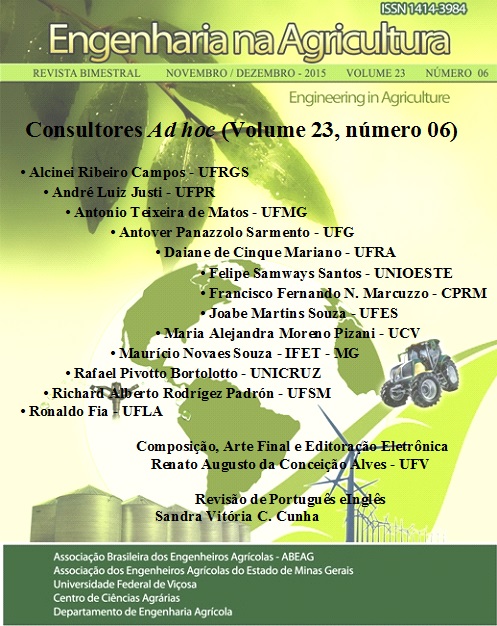MONITORING OF ELECTRICAL CONDUCTIVITY OF SOIL SOLUTION UNDER DIFFERENT DOSES OF APPLICATION OF STILLAGE - DOI: 10.13083/1414-3984/reveng.v23n6p552-561
DOI:
https://doi.org/10.13083/reveng.v23i6.590Keywords:
lixiviação, salinização, efluentes líquidos, reuso de águaAbstract
The objective of this study was to evaluate the electrical conductivity (EC) and pH of soil solution cultivated with Vitória pineapple and fertilized with stillage to supply 0, 50, 75, 100 and 125% of the potassium recommendation for this culture, obtaining treatments: T1 – 0 m³ ha-¹; T2 – 231 m³ ha-¹; T3 – 347 m³ ha-¹; T4 – 462 m³ ha-¹; T5 – 578 m³ ha-¹. The experiment was conducted in a greenhouse at the Department of Biosystems Engineering ESALQ/USP. The planting was conducted in trenches open at ground level fully lined with canvas and filled with soil classified as Oxisol. The application of stillage were performed fortnightly through fertigation system using drip irrigation. Extractors were installed at depths of 0,20 m and 0,40 m for extraction of the solution, vacuum was applied at the tension of 60kKPa two hours after the fertigation. The solution was collected 30, 120, 210 e 270 days after starts of treatments. It was found that treatments with stillage application showed the highest EC in the soil surface layers. The pH, otherwise, decrease with the increment on the vinasse levels.Downloads
Downloads
Published
How to Cite
Issue
Section
License
Authors who publish with this journal agree to the following terms:
The author(s) authorize(s) the publication of the text in the journal;
The author(s) ensure(s) that the contribution is original and unpublished and that it is not in the process of evaluation by another journal;
The journal is not responsible for the views, ideas and concepts presented in articles, and these are the sole responsibility of the author(s);
The publishers reserve the right to make textual adjustments and adapt texts to meet with publication standards.
From submission, the author is fully conceding the paper's patrimonial rights to the publication, but retaining the owner of its moral rights (authorship and paper's identification) according to Creative Commons Attribution-Noncommercial.








 Licensed by
Licensed by 